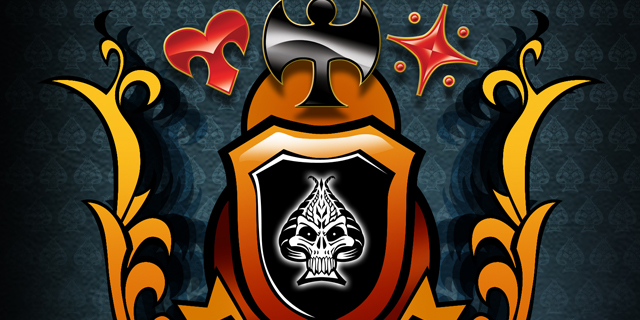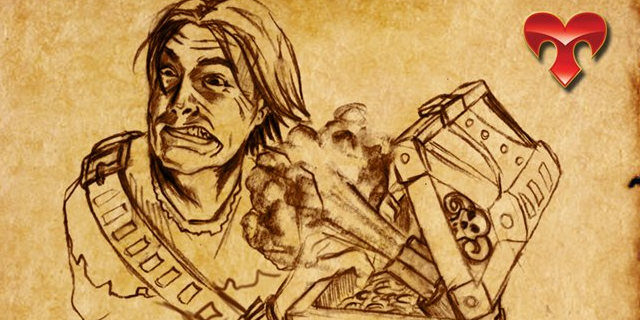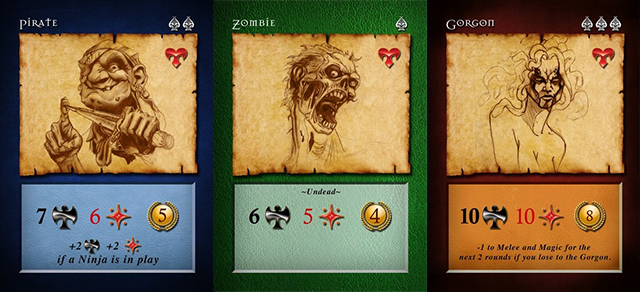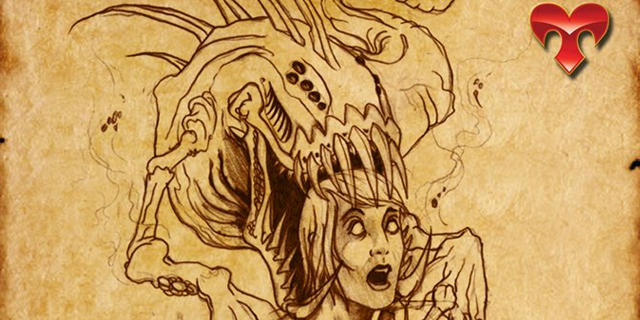
Last year I talked about Dragon Whisperer, a fine if unremarkable trick-taking game with some beautiful art design but no substance to match it. Playing Dragon Whisperer left me wanting more from the intersection of Hearts-style game play and fantasy adventure. Amazingly, a few months later I stumbled upon the Kickstarter campaign for Tricked-Out Hero from Prolific Games, which appeared to offer just that and decided to give it some support.
In Tricked-Out Hero, players each select a character from a typical D&D-style roster of heroes. Each hero has ratings for starting and maximum health, as well as initial melee and magic ratings. Each hero also has a “declaration” power as well as several combat powers that helps to define that character in gameplay.
A game of Tricked-Out Hero takes place over three levels of adventure, with each level being comprised of a number of rounds equal to the number of players. At the beginning of each round, each player is randomly dealt a monster from the corresponding level deck followed by a hand of traditional playing cards. One suit each round is declared trump by a four-card deck that gets shuffled every four rounds.
Starting with the player to the left of the dealer, each player has the option of using their character’s declaration power or passing. Once someone has opted to use their power, no other player may do so for that hand. These powers can have significant impact on how the hand plays out but have a limited number of uses each game so using them wisely will be in your best interest.

Once a declaration power has been used (or everyone passed on doing so), the hand begins as normal in a mostly traditional trick-taking manner. Players must follow suit if possible, but are free to play whatever they wish if they cannot do so. The winner of each trick keeps the card they used to win face-up in front of them and puts the rest in the discard pile.
At the end of the round, players receive one token of the appropriate suit per card in front of them: melee for clubs, magic for diamonds and hearts for health. (I’ll get to spades later.) Since health (hearts) has a maximum value, every two additional heart tricks instead translate to a different token of that player’s choice, although a single extra heart is wasted. Should a player manage a nil hand (no tricks won), they get three tokens of their choice.
From there the round proceeds to the combat phase and each player reveals their monster. Each monster has a rating for both melee and magic, as well as loot points (gold), a penalty if they are not defeated, and occasionally additional rules as appropriate. In turn, each player chooses how they wish to fight their assigned monster.
In order to beat a monster, a player must meet or exceed the monster’s rating in the chosen method of attack on an eight-sided die. Prior to rolling, players may spend as many of the appropriate tokens as they wish in order to reduce the target value by one per token spent. Unfortunately, every monster token (spade) the player has collected that round will add to the chosen value, so you will often need to spend melee/magic to offset that penalty if nothing else.

If the roll is successful, the monster is defeated and the player adds that card to their bounty pile for end-game scoring. If unsuccessful, they suffer whatever penalty is listed on the monster and then the monster is discarded. A player who runs out of health dies, but is revived at their starting values. The good news is that they keep all of their bounties, but the bad news is they also receive a Death Token. This penalty acts as a permanent monster token until removed, which is not something you really want hanging over your head.
This process repeats with the dealer shifting one seat each round until each player has been dealer once. This is the end of the level, and players receive one or more bonus tokens of their choice depending on the number playing and the new level being approached. After three levels, whichever player has the most gold wins, with ties being broken by the number of defeated monsters.
It is vitally important to know in advance that monsters get dramatically more difficult as the game advances. Spending too many tokens early will make it almost impossible for you to step up against the monsters you encounter later on, so risk management is key. A target number of five is basically a 50% chance of success, and anything lower than that is probably just greedy unless the consequences for failure are too high.
Things get really strange for the one round out of every four in which spades are trump. Barring a character power having some say in this, these rounds are a “bizarro-world” inversion where holding trump cards — especially the unbeatable ace of spades and probably most of the other face cards as well — is more of a curse than a blessing. Spades in general are an interesting twist to normal trick-taking, as you never really want to win a trick where spades has been led. In fact, leading a trick with a low-value spade in Tricked-Out Hero is a good way to make enemies around the table. Fortunately only the winning card actually counts for or against you, unlike in Hearts where you are penalized for simply collecting the offending suit.

While I like what Tricked-Out Hero does, the design is not without its flaws. Chief among these is the substandard card stock used for the various decks. This isn’t much of an issue for the monster decks, but the trick deck absolutely will not withstand the amount of shuffling it has to go through. I cannot recommend sleeving this deck enough, although you can also substitute any random deck of poker cards if you don’t mind losing the customized suits and artwork of the original.
Tricked-Out Hero‘s other main drawback is how poorly it scales. Every player added to the game extends the play time by at least 20 minutes, if not more. With special two-player rules and two additional joker cards (optional for five-player games, required for six) the game can cover a wide gamut of players, but has the potential to wear out its welcome with more than three or four. This is especially true when you consider that the number of tokens each player can expect to receive each round goes down, as the same number of cards is divided among more players for fewer tricks.
Still, Tricked-Out Hero is a distinct enough experience that I recommend it to anyone who wants to beat up some monsters without going through the whole RPG set-up. The different heroes give the game both a high replay value and an easy route for future expansion. In fact, the first expansion, Into the Wild, is already being advertised on the side of the Tricked-Out Hero box, although details on that are vague at best at this time.
Tricked-Out Hero retails for $45.



















